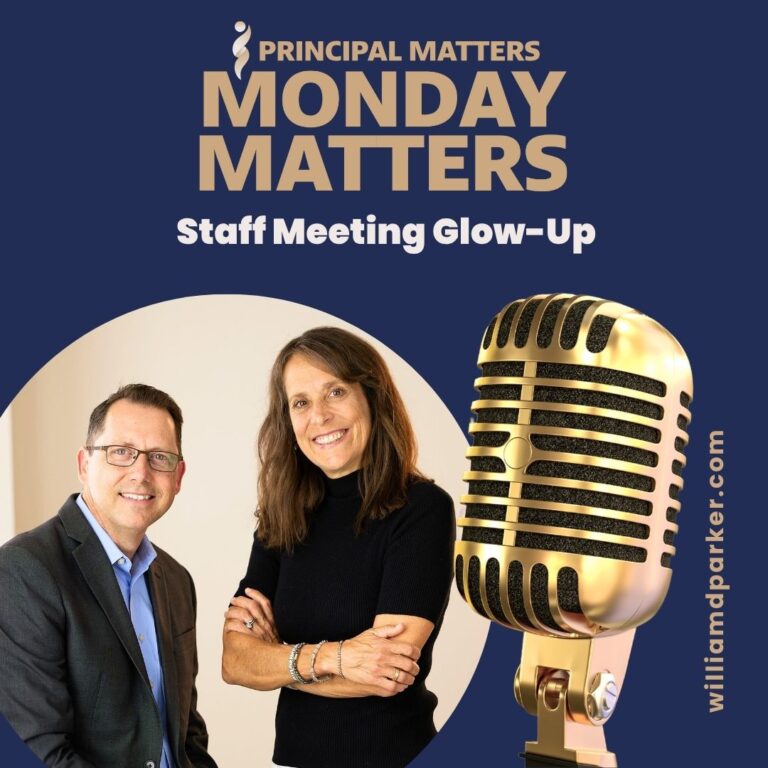Podcast: Play in new window | Download
This week I did my first in-person meeting with a group of fellow-school leaders as they plan for the beginning of a new school year.

The team of administrators sat in a room with tables at appropriate distances, and we wore masks. Whenever I wear a mask, my glasses become foggy. So I held my glasses in one hand while we talked through topics on school culture, planning for the upcoming year, supporting teachers in the “new norms” ahead. As we took turns sharing ideas and reflecting together, I noticed how different interactions can be wearing masks.
We couldn’t see mouths or full facial expressions. We had to talk talk louder than normal and really enunciate words. But as the session continued, everyone seemed to become less mask-distracted and more focused on discussions and problem solving.
In the weeks and months ahead, I don’t know what is in store for you. You may be alternating days students come to school. Or perhaps your district is beginning with all students in remote learning. Maybe you are in a location where in-person is beginning with blended or virtual options together.
As I’ve connected with leaders in my own state and across the U.S., I am hearing so many different plans. But all of them have one thing in common: No one has ever done school like this before.
We are all Tweeners. In Dr. Anthony Muhammad’s excellent book, Transforming School Culture: How to Overcome Staff Division (Leading the Four Types of Teachers and Creating a Positive School Culture), he identifies four types of educators who make up the culture of any school. He calls them Believers, Tweeners, Survivors, and Fundamentalists.
Check out PMP202 if you want to hear Dr. Muhammad explain each category in our interview together. But for the sake of this post, I want to remind you that a Tweener is someone new to the profession, impressionable, and looking for feedback. A Tweener is also most susceptible to the healthy or toxic cultures he or she encounters.
In other words, Tweener educators most need mentors who are optimistic and encouraging because they are desperately searching for their own identity in their new surroundings. A good fellow-educator can be a lifeline for a Tweener who needs strong role-modeling and encouragement in his or her first year.
Educators have a unique challenge this year, however. Even though some are more experienced than others or have weathered crises in the past, no one has weathered a global pandemic of this proportion in our lifetime.
Let me be clear. Optimism and hope are essential if we are going to lead forward during the days ahead. It doesn’t mean you cannot be transparent or admit your disappointment or frustrations. But it does require a commitment.
The ability for you to lead forward with hope will often be the catalyst that drives your school culture. Don’t get me wrong. You are not responsible for the attitude of others. But your attitude does affect others, like it or not.
So ask yourself some important questions: Is my attitude one of hope or resignation? Do I believe we have the capacity to serve children in the days ahead, no matter what? Am I willing to look for the next solution even if that means shifting plans that no longer work?
This will not be easy. But easy does not require leadership. Overcoming difficulty does.
Mountain Climbing
A few weeks ago, my family and I drove west for a few days in the national parks near Moab, Utah. It was a great time to social distance, walk the long trails in red canyons, and take a break from computer screens and the stress of current events.
Just above Moab are the La Sal Mountain range. My 14-year old son Jack, and I love mountain hiking, and we planned one morning to see if we could summit a nearby peak.
The morning of our climb, we arrived at the trail head shortly after sun-up. The day before, the weather had been in the 90’s, fahrenheit, as we visited the canyons near Moab. But when we sumitted the hills of the La Sal Mountain range, the temperature kept dropping with the elevation.
When we stepped out of our car, it was 32 degrees Fahrenheit, and the forest floor was covered in a light coating of snow. “You sure you want to make this climb?” I asked him. We had packed water for 8-10 hours, but we were wearing shorts, thin shirts, hoodies and ball caps. We hadn’t packed gloves or windbreakers.
“We can do this,” he said. So with backpacks filled with water bladders and snacks, we headed into the trail. Our goal was Mann’s Peak, a little more than 11,000 feet at the top, and the trail head began about 2.5 miles from the ascent. This meant with elevation changes, switchbacks and navigating through snow, we’d reach the top in about 4 hours.
If you’ve climbed in elevation before, you know that the beginning is usually the easy part. But as oxygen becomes thinner, the climb progressively becomes harder. We were mesmerized by the beauty of pines, rambling creeks, and occasional deer. Later the trees changed to Aspen and large swaths were fallen or broken from avalanches that had occurred during winter months.
Thankfully, the weather warmed as we hiked. When we hit the switchbacks, however, our climbing slowed. We could see the tree lines above us, and as we climbed, I began using a walking stick to support me. Jack climbed like a young deer, his fourteen year old legs carrying him carelessly along. But my 51-year-old legs, although used to my normal running schedule, could not keep up. Mostly it was the breathing that stopped me.
At one point in our climb, I was struggling to breathe. So Jack waited for me to catch up.
“See that bush just ahead?” he asked. “Let’s make it there and we’ll stop again.”
That became our pattern. Jack would march ahead. I would take one heavy step after another, leaning on my walking stick like and plod along until I could catch up.
Finally, we made it above the tree lines. Looking back below us, you could see the winding trails running through valleys, trees, and into the green miles below us. We could see several peaks along hills that formed the saddleback above the treeline. But just then the winds picked up. Without the cover of trees, we were exposed to a bitter wind that blew so hard we had to hold our hats onto our heads so they didn’t blow away.
And the temperatures were colder above the treeline. I could feel my fingers going numb. Jack and I looked at each other.
“Listen,” I said, “The way forward will be pretty painful. Are you up for this?”
We looked at the ridge of peaks, and Jack pointed to the closest one.
“Let’s just make it to the top of the closest one,” he said, “Then we’ll move back down into the treeline. It’s too cold to stay up here long.”
“Let’s do it,” I said.
Jack took off like a deer again. Up the rocks he began to climb. The first peak soon turned completely into a stone ascent of small boulders, each still covered in white from snow. He climbed ahead, and I followed. The biggest challenge was not being able to stand upright. In order to move ahead, we had to bear crawl, using our hands and our feet to move up the rocks. I could feel my fingers growing colder. I grabbed my hat and held it in my right hand as a glove while I crawled.
Before long Jack had lengthened the distance between us. I looked up to see him standing near the top of the peak. He had turned to look at me. Just then the sun over his shoulder to the east pierced through the clouds. As Jack stood there silhouetted against the rocky, snowy face of those rocks, I noticed he was wearing a mask. Because of COVID alerts, we had placed surgical masks in our pockets in case we ran into other hikers. I grabbed mine from my pocket and put it on as well.
Suddenly, Jack was standing beside me. He had come back down from the hill. “Dad, it’s too cold,” he said. “I don’t think we’ll make it to the top.”
With the gusting winds and masks, we were yelling to hear one another.
“You’re so close,” I said. “Keep going. If I don’t make it, it’s okay. I want you to reach the goal.”
He turned, and darted up the rocks. I plodded on. Rock after rock. Cold fingers turning red and numb. Feet slipping in the crevices of small boulders. And suddenly I was there. Jack was standing on the peak looking back at me. Once we were there, we spotted a line of rocks with a small decline into an open green area of grass. We slid behind this natural windbreak.
After catching our breath, we took off our masks and looked around. If you’ve ever climbed the summit of a mountain, you know what that moment is like when you are on the top of the world. The valleys and other mountain ranges lay before – a panorama of trees, rocks, valleys, clouds and sunlight. We sat down, unpacked our lunches and soaked it in while we rested.
“We made it,” I said.
“I’ve never been so tired in my life,” Jack replied.
“Was it worth it?” I asked.
“Yes.”
This past week, Jack and I were looking through the photos from that climb. “Dad,” he told me. “I think that will be one of the best memories of my life. I can’t remember ever doing anything so hard.”
As I wrapped up my visit with the team of school leaders this week, I shared the climbing story with them. I explained that as I’ve thought about our climb and Jack’s words this week, I couldn’t help but think of the mountain educators are preparing to climb in the days and months ahead. Whether your district has decided to begin classes remotely or in-person, no scenario will be easy. You’ll be navigating paths none of us has ever climbed before.
What to expect in a hard climb
- Hard climbs require courage and determination.
- They require planning for the knowns and expecting quick decisions when you face unknowns.
- The climb is easier with strong teamwork and encouragement from one another.
- Hard climbs with teams require selfless moments and looking out for others.
But something else surprised me in my climbing story. In our most difficult moment, the one item I never expected to help was a mask. Who would have ever thought those masks would provide us just enough protection from the elements and cold to keep us moving forward to reach our goals?
Let’s Wrap This Up
If you are like me, you are not looking forward to a school year of protocols and personal protective equipment. You’re not looking forward to blended options, virtual meetings, or social distancing. And it’s okay to admit that.
But it’s also important to realize you are not climbing the mountains ahead by yourself.
As educators, we are all in this together.
No one has more experience than anyone else in mitigating the factors of school leadership during a global pandemic.
No one understands the best outcomes yet for combining remote learning with entire cities or communities of school children.
No one knows when the numbers will finally decline to levels where we return to life before COVID-19.
But we do know this: We always face obstacles better when we move forward together with hope…when we commit with determination…when we rely on teamwork.
And who knows, someday we may even look back at all the masks and see how in the end, they helped us reach new summits together.
Now It’s Your Turn
How would you describe your own emotions going into the new semester? Be honest. Then ask yourself, how can you support those on your teams with how they are feeling moving forward. Be the one who commits to hope, and reach out to at least one other educator to remind them that you are pioneering in this together.




